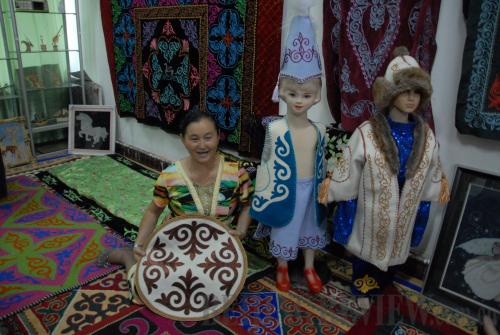|
 |
|
A HANDY SKILL: Lina Ahan shows an embroidery product she designed in a souvenir store in Buerqin County on July 30 (BAI SHI) |
In the afternoon of July 30, several Kazak women sat together in a spacious room in Burqin County, a beautiful border area in north Xinjiang Uygur Autonomous Region, and embroider traditional handicrafts. The finished products of various categories, such as tapestry, clothes, hats and souvenirs, are placed in order on shelves in the room. Their fingers are so nimble and adept that the animal patterns seem to be alive. Lina Ahan, 52, is the head of this embroidery workshop. She is also an honorable person in the county known for helping a number of unemployed women find new jobs.
But she never expected to become a well-respected person when she was laid off from a bankrupt local state-owned department store in 1993.
"I didn't have a stable job until 2005 when I got into the embroidery business," Ahan told Beijing Review.
Along with the tourism boom in Burqin where the famous Kanas Lake lies, the Kazak handicrafts are becoming more and more popular among visitors. Ahan found the huge potential of the ethnic embroidery industry, winning more orders thanks to high quality and creative designs.
In 2007, Ahan embraced a big change in her business. The county's Women's Federation launched a scheme to offer financial support for unemployed women to start or expand their businesses. Soon, Ahan opened an embroidery workshop, employing 25 laid-off women. The workshop's earnings increased year by year.
In 2010, Ahan's workshop moved to a larger building and added new embroidery machines. Meanwhile, she opened several retail outlets, establishing an integrated chain from production to sales. Ahan attends various trade fairs in Xinjiang every year, such as the China-Eurasia Expo in Urumqi every September. The expo is the largest of its kind in the region.
"Our products are also sold to foreign countries. We have our own brand, Dastur, covering over 200 categories. The trade fairs help us promote our brand," Ahan said. "Moreover, at the fairs I am able to know the market trends and what kinds of products consumers like."
According to Ahan, her workshop can earn 120,000 yuan ($18,891) per year. On average, a female embroidery worker in the workshop has a stable income of 8,000 yuan ($1,259) per year.
Despite leading a rich life, Ahan is devoted to helping other women improve their livelihood. She often visits villages and towns to teach women embroidery skills.
Ahan is director of the Handicraft Association of Burqin. With the help of the association, more than 700 women have been employed in embroidery work.
Nurlan, a souvenir store manager in Burqin, was also laid off from her previous job. She learned embroidery skills from Ahan three years ago. Last July, Nurlan opened a store to sell Ahan's workshop's products. In addition to Ahan's help, the country's Women's Federation subsidized the housing rent of the store.
"There are a lot of customers in our store in the tourist season. They like Kazak embroidery very much," Nurlan said. "My life has improved a lot thanks to the help of Ahan and other kind people."
Ahan pays great attention to adding new elements to traditional embroidery patterns. She has won many awards in embroidery design contests in Xinjiang. Ahan and her colleagues have designed 12 kinds of nationally patented products.
"I feel happy these days. My husband and I each receive a pension of 1,500 yuan ($236) per month. My son entered a university in Beijing last year. But I cannot live an idle life. I want to do something for other people and help them improve their lives," Ahan said.
Email us at: baishi@bjreview.com
| 